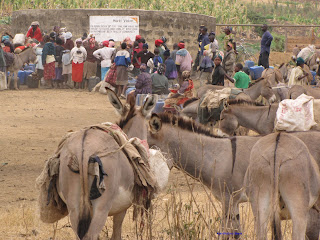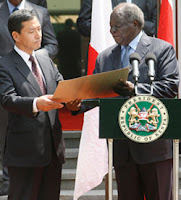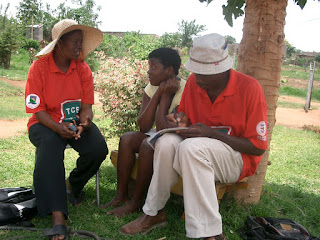 |
| EstherWambui/Photos |
This image captures the eye. It may also catch you for its beauty: A donkey in full motion and a young boy doing his best to keep up, the stick in his hand to whip the donkey if it slows down. It's a beautiful image I think, the urgency of it expressed in its blurriness. But it is this urgency that is at the heart of my ache.
On the day I visited Maiella , it became apparent long before we arrived that water was scarce in this region. Along the way to my relatives’ place, we met every mode of transportation - boda boda, donkeys, women’s backs and bicycles - carrying one or more mitungis [Jerrycans] of water. Maiella suffers tremendous water shortage.
But what really drove the point home for me was actually observing the long queues for water at the World Vision water supply point.
For now though, let’s return to the running boy and donkey. The boy [let's call him Kamau] is still wearing his school uniform. It's around 5:30pm. He just came home from all-day school only to find empty water containers waiting for him. I imagine him hurriedly strapping the donkey and heading off to fetch water before darkness sets in. He doesn't have to be told to go for water, it's his daily after-school chore after all. It's also possible that he hasn't had any water to drink as the last drop was used up earlier in the day.
So off Kamau goes, running to the water point only to be terribly disappointed. Moments earlier, I had watched as some people were turned away because the water ran out. It's hard to comprehend how you'd feel after two hours of queuing, only to leave with dry containers. With no other option, the people grumbled on their way home, to make do with whatever little water if any they had left.
Kamau on the other hand couldn’t afford the luxury of returning home. He had to go for water from the next distribution point, an hour and a half one way walking distance. He wouldn’t be back before 9 P.M, I was informed.
| EstherWambui/Photos |
I asked around why there wasn't enough water for everyone who needed it. Obviously, the administrators could only pump water into the only available tank, which they did overnight. Some people were quick to blame the government, particularly local authorities. Apparently during the construction of the single tank, World Vision knew one tank wouldn’t cater to everyone's water needs. Yet, their application/request to build more tanks was denied. It is believed that the local authorities want the water shortage situation to continue so that they can charge higher than average for water - a corruption strategy that keeps their pockets well lined with ill-obtained cash.
So as it stands, the people of Maiella continue their daily struggle, looking forward to a short reprieve during the rainy season. It’s the only time they and their beasts of burden can take a breather while preparing for the next hot, dry, waterless season. For this season always comes.
Yet another critical area where Kibaki could have invested Kenya’s million bucks!




